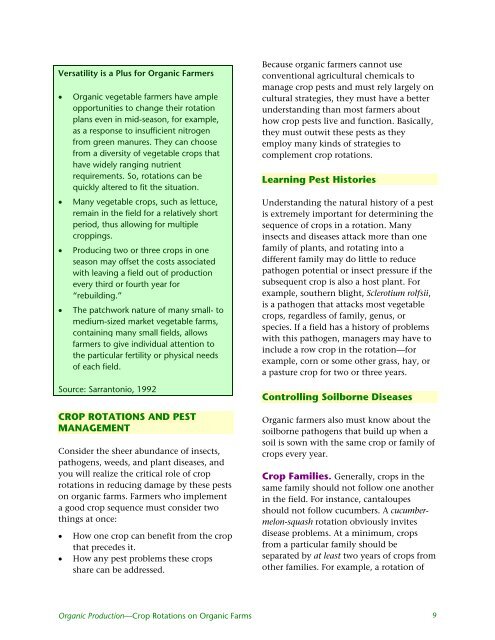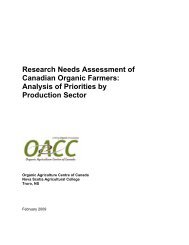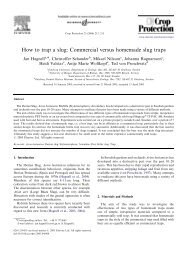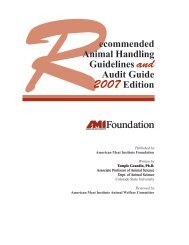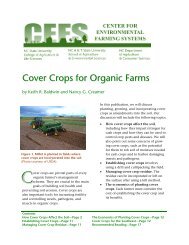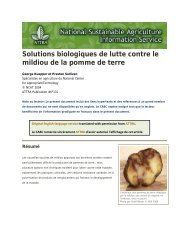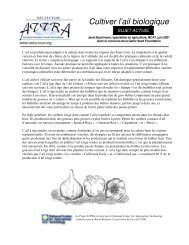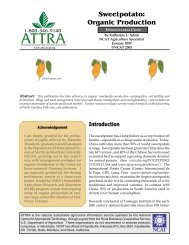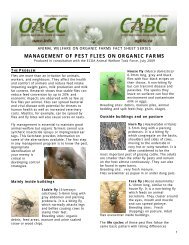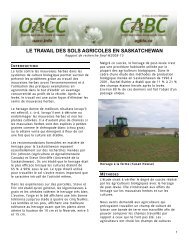You also want an ePaper? Increase the reach of your titles
YUMPU automatically turns print PDFs into web optimized ePapers that Google loves.
Versatility is a Plus for <strong>Organic</strong> Farmers• <strong>Organic</strong> vegetable farmers have ampleopportunities to change their rotati<strong>on</strong>plans even in mid-seas<strong>on</strong>, for example,as a resp<strong>on</strong>se to insufficient nitrogenfrom green manures. They can choosefrom a diversity of vegetable crops thathave widely ranging nutrientrequirements. So, rotati<strong>on</strong>s can bequickly altered to fit the situati<strong>on</strong>.• Many vegetable crops, such as lettuce,remain in the field for a relatively shortperiod, thus allowing for multiplecroppings.• Producing two or three crops in <strong>on</strong>eseas<strong>on</strong> may offset the costs associatedwith leaving a field out of producti<strong>on</strong>every third or fourth year for“rebuilding.”• The patchwork nature of many small- tomedium-sized market vegetable farms,c<strong>on</strong>taining many small fields, allowsfarmers to give individual attenti<strong>on</strong> tothe particular fertility or physical needsof each field.Source: Sarrant<strong>on</strong>io, 1992CROP ROTATIONS AND PESTMANAGEMENTC<strong>on</strong>sider the sheer abundance of insects,pathogens, weeds, and plant diseases, andyou will realize the critical role of croprotati<strong>on</strong>s in reducing damage by these pests<strong>on</strong> organic farms. Farmers who implementa good crop sequence must c<strong>on</strong>sider twothings at <strong>on</strong>ce:• How <strong>on</strong>e crop can benefit from the cropthat precedes it.• How any pest problems these cropsshare can be addressed.Because organic farmers cannot usec<strong>on</strong>venti<strong>on</strong>al agricultural chemicals tomanage crop pests and must rely largely <strong>on</strong>cultural strategies, they must have a betterunderstanding than most farmers abouthow crop pests live and functi<strong>on</strong>. Basically,they must outwit these pests as theyemploy many kinds of strategies tocomplement crop rotati<strong>on</strong>s.Learning Pest HistoriesUnderstanding the natural history of a pestis extremely important for determining thesequence of crops in a rotati<strong>on</strong>. Manyinsects and diseases attack more than <strong>on</strong>efamily of plants, and rotating into adifferent family may do little to reducepathogen potential or insect pressure if thesubsequent crop is also a host plant. Forexample, southern blight, Sclerotium rolfsii,is a pathogen that attacks most vegetablecrops, regardless of family, genus, orspecies. If a field has a history of problemswith this pathogen, managers may have toinclude a row crop in the rotati<strong>on</strong>—forexample, corn or some other grass, hay, ora pasture crop for two or three years.C<strong>on</strong>trolling Soilborne Diseases<strong>Organic</strong> farmers also must know about thesoilborne pathogens that build up when asoil is sown with the same crop or family ofcrops every year.<str<strong>on</strong>g>Crop</str<strong>on</strong>g> Families. Generally, crops in thesame family should not follow <strong>on</strong>e anotherin the field. For instance, cantaloupesshould not follow cucumbers. A cucumbermel<strong>on</strong>-squashrotati<strong>on</strong> obviously invitesdisease problems. At a minimum, cropsfrom a particular family should beseparated by at least two years of crops fromother families. For example, a rotati<strong>on</strong> of<strong>Organic</strong> Producti<strong>on</strong>—<str<strong>on</strong>g>Crop</str<strong>on</strong>g> <str<strong>on</strong>g>Rotati<strong>on</strong>s</str<strong>on</strong>g> <strong>on</strong> <strong>Organic</strong> <strong>Farms</strong> 9


